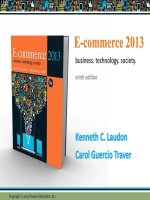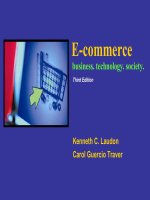Lecture E-commerce 2013: Business, technology, society (9/e): Chapter 3 - Kenneth C. Laudon, Carol Guercio Traver
Bạn đang xem bản rút gọn của tài liệu. Xem và tải ngay bản đầy đủ của tài liệu tại đây (1.48 MB, 53 trang )
E-commerce 2013
business. technology. society.
ninth edition
Kenneth C. Laudon
Carol Guercio Traver
Chapter 3
E-commerce Infrastructure: The Internet,
Web, and Mobile Platform
Copyright © 2013 Pearson Education, Inc.
Class Discussion
Google Glass: Augment My Reality
Have you used any augmented reality applications?
If so, has it been useful; if not, is it a service that
seems interesting? Why or why not?
Are there any privacy issues raised by augmented
reality applications?
What are the potential benefits to? Are there any
disadvantages?
What revenue models could work for providers of
augmented services?
Copyright © 2013 Pearson Education, Inc.
Slide 3-3
The Internet: Technology Background
Internet
Interconnected network of thousands of
networks and millions of computers
Links businesses, educational institutions,
government agencies, and individuals
World Wide Web (Web)
One of the Internet’s most popular services
Provides access to billions, possibly trillions, of
Web pages
Copyright © 2013 Pearson Education, Inc.
Slide 3-4
The Evolution of the Internet
1961–Present
Innovation Phase, 1964–1974
Creation of fundamental building blocks
Institutionalization Phase, 1975–1995
Large institutions provide funding and
legitimization
Commercialization Phase, 1995–present
Private corporations take over, expand Internet
backbone and local service
Copyright © 2013 Pearson Education, Inc.
Slide 3-5
The Internet:
Key Technology Concepts
Defined as network that:
Uses IP addressing
Supports TCP/IP
Provides services to users, in manner similar to
telephone system
Three important concepts:
Packet switching
TCP/IP communications protocol
Client/server computing
Copyright © 2013 Pearson Education, Inc.
Slide 3-6
Packet Switching
Slices digital messages into packets
Sends packets along different communication paths
as they become available
Reassembles packets once they arrive at
destination
Uses routers
Special purpose computers that interconnect the computer
networks that make up the Internet and route packets
Routing algorithms ensure packets take the best available path
toward their destination
Less expensive, wasteful than circuit-switching
Copyright © 2013 Pearson Education, Inc.
Slide 3-7
Packet Switching
Figure 3.3, Page 123
Copyright © 2013 Pearson Education, Inc.
Slide 3-8
TCP/IP
Transmission Control Protocol (TCP):
Internet Protocol (IP):
Establishes connections among sending and receiving Web
computers
Handles assembly of packets at point of transmission, and
reassembly at receiving end
Provides the Internet’s addressing scheme
Four TCP/IP layers
Network interface layer
Internet layer
Transport layer
Application layer
Copyright © 2013 Pearson Education, Inc.
Slide 3-9
The TCP/IP Architecture and Protocol Suite
Figure 3.4, Page 125
Copyright © 2013 Pearson Education, Inc.
Slide 3-10
Internet (IP) Addresses
IPv4:
32-bit number
Four sets of numbers marked off by periods:
201.61.186.227
Class C address: Network identified by first three
sets, computer identified by last set
IPv6
128-bit addresses, able to handle up to 1
quadrillion addresses (IPv4 can only handle 4
billion)
Copyright © 2013 Pearson Education, Inc.
Slide 3-11
Routing Internet Messages: TCP/IP and
Packet Switching
Figure 3.5, Page 126
Copyright © 2013 Pearson Education, Inc.
Slide 3-12
Domain Names, DNS, and URLs
Domain name
IP address expressed in natural language
Domain name system (DNS)
Allows numeric IP addresses to be expressed in natural
language
Uniform resource locator (URL)
Address used by Web browser to identify location of
content on the Web
E.g. />
Copyright © 2013 Pearson Education, Inc.
Slide 3-13
Client/Server Computing
Powerful personal computers (clients)
connected in network with one or more
servers
Servers perform common functions for
the clients
Storing files
Software applications
Access to printers, etc.
Copyright © 2013 Pearson Education, Inc.
Slide 3-14
The New Client:
The Mobile Platform
In a few years, primary Internet access
will be through:
Tablets
Supplementing PCs for mobile situations
Smartphones
Disruptive technology:
Shift in processors, operating systems
25% of all cell phones
Copyright © 2013 Pearson Education, Inc.
Slide 3-15
Cloud Computing
Firms and individuals obtain computing
power and software over Internet
e.g., Google Apps
Fastest growing form of computing
Radically reduces costs of:
Building and operating Web sites
Infrastructure, IT support
Hardware, software
Copyright © 2013 Pearson Education, Inc.
Slide 3-16
Other Internet Protocols and
Utility Programs
Internet protocols
HTTP
E-mail: SMTP, POP3, IMAP
FTP, Telnet, SSL/TLS
Utility programs
Ping
Tracert
Copyright © 2013 Pearson Education, Inc.
Slide 3-17
The Internet Today
Internet growth has boomed without
disruption because of:
Client/server computing model
Hourglass, layered architecture
Network Technology Substrate
Transport Services and Representation Standards
Middleware Services
Applications
Copyright © 2013 Pearson Education, Inc.
Slide 3-18
The
Hourglass
Model of
the
Internet
Figure 3.11, Page 134
Copyright © 2013 Pearson Education, Inc.
Slide 3-19
Internet Network Architecture
Backbone:
IXPs:
High-bandwidth fiber-optic cable networks
Private networks owned by a variety of NSPs
Bandwidth: 155 Mbps–2.5 Gbps
Built-in redundancy
Hubs where backbones intersect with regional and local networks,
and backbone owners connect with one another
CANs:
LANs operating within a single organization that leases Internet
access directly from regional or national carrier
Copyright © 2013 Pearson Education, Inc.
Slide 3-20
Internet Network Architecture
Figure 3.12, Page 135
Copyright © 2013 Pearson Education, Inc.
Slide 3-21
Internet Service Providers (ISPs)
Provide lowest level of service to
individuals, small businesses, some
institutions
Types of service
Narrowband (dial-up)
Broadband
Digital Subscriber Line (DSL)
Cable modem
T1 and T3
Satellite
Copyright © 2013 Pearson Education, Inc.
Slide 3-22
Intranets and Extranets
Intranet
TCP/IP network located within a single
organization for communications and
processing
Extranet
Formed when firms permit outsiders to access
their internal TCP/IP networks
Copyright © 2013 Pearson Education, Inc.
Slide 3-23
Who Governs the Internet?
Organizations that influence the Internet and
monitor its operations include:
Internet Architecture Board (IAB)
Internet Corporation for Assigned Names and Numbers
(ICANN)
Internet Engineering Steering Group (IESG)
Internet Engineering Task Force (IETF)
Internet Society (ISOC)
World Wide Web Consortium (W3C)
International Telecommunications Union (ITU)
Copyright © 2013 Pearson Education, Inc.
Slide 3-24
Insight on Society: Class Discussion
Government Regulation and
Surveillance of the Internet
How is it possible for any government to “control”
or censor the Web?
Does the Chinese government, or the U.S.
government, have the right to censor content on
the Web?
How should U.S. companies deal with governments
that want to censor content?
What would happen to e-commerce if the existing
Web split into a different Web for each country?
Copyright © 2013 Pearson Education, Inc.
Slide 3-25









